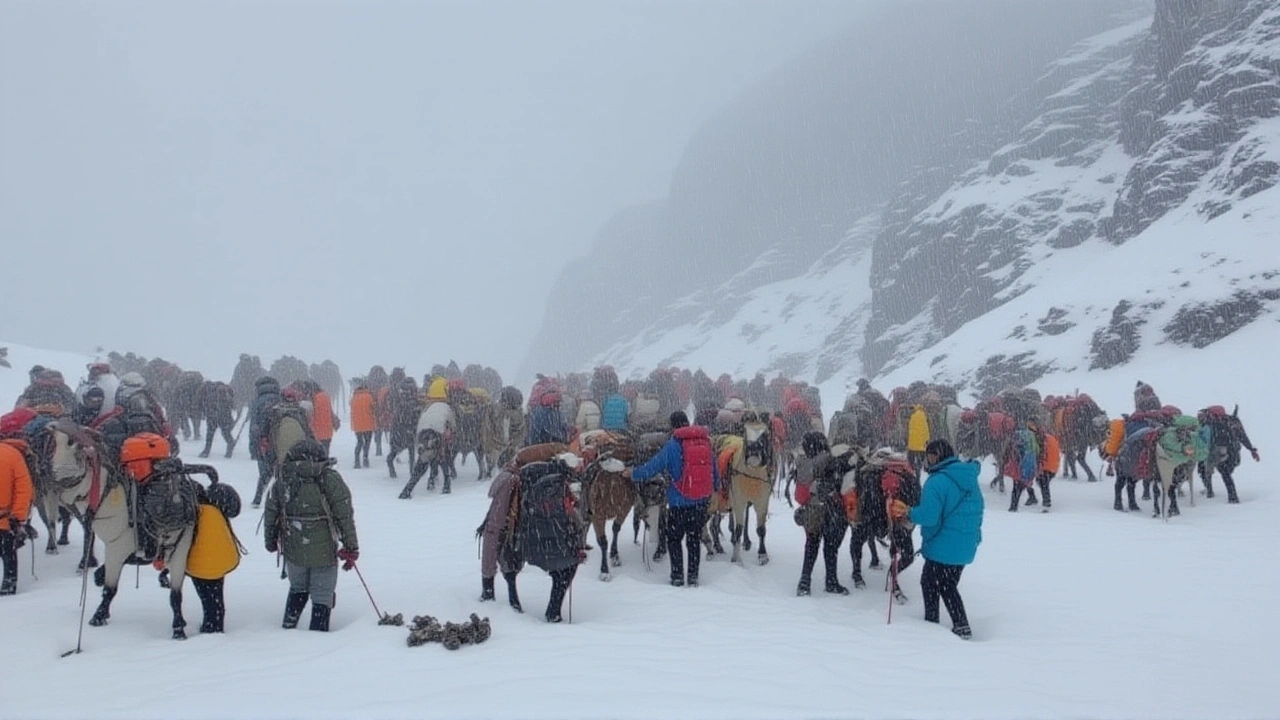Blizzard Traps Hundreds on Everest; Rescue Teams Battle Snow in Tibet

When a sudden snowstorm slammed Mount Everest this weekend, almost a thousand trekkers found themselves stuck on a wall of white, and the world’s eyes turned to the high‑altitude drama unfolding in Tibet. The blizzard, which rolled in Friday night and intensified by Saturday morning, has left more than 350 people rescued and at least 200 still stranded near 14,000 feet, prompting a massive rescue effort coordinated by Chinese authorities.
How the Blizzard Developed
The weather pattern that slammed Everest was anything but typical for early October. Usually, this window is marked by clear skies and relatively calm winds, a sweet spot for climbers aiming for the summit or the popular trekking routes around Base Camp. This time, however, a rapid drop in temperature combined with fierce southerly winds created a classic alpine blizzard. Snowfall rates topped 30 centimeters per hour, and visibility plunged to less than a hundred meters—conditions that can turn a seasoned mountaineer into a frightened child.
Local meteorologists, working with the China Meteorological Administration, say the storm was triggered by a sudden influx of cold air from the Siberian High, meeting moist monsoon flows from the Indian Ocean. The clash sparked the heavy precipitation that caught trekkers off guard.
Rescue Operations in Motion
Rescue crews, mainly helicopter units from the People's Government of the Tibet Autonomous Region, launched the first missions early Saturday. Unfortunately, the swirling winds and white‑out conditions grounded many flights, forcing teams to rely on rope‑teams and high‑altitude porters to reach the stranded groups.
According to Britt Clennett, foreign correspondent for ABC News, "authorities have made contact with several camps still buried in snow, and they're prioritizing the most vulnerable, especially older trekkers and children." The reporters on the ground heard the distant hum of helicopter rotors, a sound that has become a lifeline for many.
One of the rescued is Chen Schwang, a 32‑year‑old mountaineer who described the ordeal as "a living nightmare that turned into a miracle when the rescue team found our camp." After being airlifted to the nearby town of Qomolangma, locals greeted her with steaming cups of butter tea, boiled yak milk, and hearty dumplings—comfort food that seemed to melt the ice in her bones.
Voices from the Mountains
Survivors told reporters that the snow arrived with “no warning.” One unnamed trekker said, "We were sitting around a campfire, chatting, when the sky turned gray in seconds. It felt like the world was swallowing us whole." Another, a veteran guide named Lobsang Tsering, said he had warned clients about possible storms, but the rapid onset made it impossible to evacuate in time.
Family members back home are glued to their phones, waiting for any update. A mother from Kathmandu, whose son is still missing, told me, "Every hour feels like a day. I keep replaying the last video call we had, hoping he'll be safe." The emotional toll is palpable, and the authorities are doing what they can to keep families informed, though official communication has been limited due to the remote location.
What This Means for Future Expeditions
The incident has reignited the debate over the safety of high‑altitude tourism in the Himalayas. Experts warn that climate change is making weather patterns more erratic, turning once‑predictable windows into “risk zones.” Dr. Ming Zhao, a climatologist at Tsinghua University, noted, "We're seeing a shift in the timing and intensity of storms. This blizzard is a sign that trekkers can no longer rely on historical weather data alone."
Tour operators are now urged to reassess their safety protocols, incorporate real‑time satellite monitoring, and perhaps lengthen the mandatory acclimatization periods to allow for quicker evacuations.
Looking Ahead
As of Sunday night, rescue teams have an estimated 30‑hour window before the storm eases, after which they hope to air‑lift the remaining climbers. The Chinese authorities have set up temporary shelters at lower elevations and are distributing blankets, high‑energy rations, and portable heaters.
In the meantime, the global trekking community watches anxiously, hoping for a full accounting of those rescued and, ultimately, the safe return of those still caught in the white abyss.
- Key Facts
- Storm began Friday night, peaked Saturday.
- ~1,000 hikers affected; 350+ rescued.
- 200+ still stranded near 14,000 ft.
- Rescue led by the People's Government of the Tibet Autonomous Region.
- Chen Schwang among rescued, welcomed with local tea and food.
Frequently Asked Questions
How many trekkers are still stranded on Everest?
At least 200 hikers remain trapped near the 14,000‑foot mark, awaiting rescue teams that are battling high winds and low visibility.
What caused the sudden blizzard on Mount Everest?
Meteorologists attribute the storm to a clash between a cold air mass from the Siberian High and warm monsoon moisture from the Indian Ocean, creating rapid snowfall and severe winds.
Who is coordinating the rescue effort?
The rescue is being led by the People's Government of the Tibet Autonomous Region, with assistance from Chinese military helicopter units and local high‑altitude porters.
What safety changes are being discussed for future Everest treks?
Experts recommend real‑time satellite weather monitoring, stricter summit window enforcement, and extended acclimatization periods to allow quicker evacuations when storms arise.
How are families being kept informed?
Chinese authorities have set up a dedicated hotline and are providing regular updates via local radio stations, though detailed information remains limited due to the remote terrain.
15 Comments
Brandon Rosso
It’s awe‑inspiring to see how quickly nature can remind us of our limits, and the resilience of those rescued on Everest truly exemplifies the human spirit. The coordinated effort by the authorities showcases what can be achieved when we all work toward a common goal, and I have no doubt that the remaining trekkers will be safely brought down once conditions improve.
Tracee Dunblazier
While the heroics are commendable, it’s hard not to question the sheer number of unprepared tourists pouring into such a perilous zone. The industry seems to prioritize profit over safety, and that’s a disturbing trend that needs immediate correction.
Edward Garza
Another avoidable disaster.
Allen Rodi
From a logistical standpoint, the use of rope‑teams and seasoned porters is the most pragmatic approach when helicopters can’t fly. It’s also a reminder that low‑tech solutions still have a vital place in high‑altitude rescues.
Jody Webster
Seriously??!! The whole thing sounds like a plot from a bad adventure movie!!! Those guys were basically stuck in a snow‑filled nightmare... & my heart goes out to them... (sorry for the tyops).
Steve Goodger
What we are witnessing on Everest is more than just a weather event; it is an embodiment of the complex interplay between climate dynamics, human ambition, and the fragile ecosystems that cradle these lofty peaks.
First, let us consider the meteorological shift: the Siberian High colliding with monsoonal moisture is a textbook example of how atmospheric rivers can amplify precipitation in unexpected ways.
Second, the timing of this blizzard during the traditionally stable October window underscores how warming trends are eroding historical safety patterns.
Third, the sheer scale of the rescue-over 350 individuals already saved-highlights both the capability and the limits of current emergency infrastructure in remote terrains.
Moreover, the reliance on high‑altitude porters and rope‑teams illustrates a resilient, community‑driven response that modern technology alone cannot replace.
It is worth noting that the psychological impact on trekkers, especially families awaiting news, can be profound, with stress hormones remaining elevated long after the snow has melted.
From an ecological perspective, the influx of rescue helicopters, even when limited, contributes to localized emissions that may affect the delicate alpine flora.
Furthermore, the incident should catalyze a reevaluation of trekking permits, encouraging operators to adopt real‑time satellite weather monitoring and extend acclimatization periods.
These measures are not merely bureaucratic; they are essential to mitigate the risk of future entrapments.
In addition, the role of local hospitality-providing butter tea and dumplings-serves as a cultural anchor for victims, reinforcing the importance of community support in crisis situations.
While the immediacy of rescue remains paramount, the longer‑term policy implications cannot be ignored.
Policy makers must balance tourism revenue with the imperative to safeguard human life, perhaps by instituting stricter climbing window enforcement.
Finally, this event serves as a stark reminder that climate variability is not a distant future scenario but a present reality with tangible consequences for adventurers worldwide.
By learning from this episode, the international climbing community can develop more robust, adaptive strategies that honor both the allure of the mountains and the safety of those who choose to explore them.
johnson ndiritu
Looks like the rescue teams are doing a solid job 🙌🚁. Let’s give them credit for braving those insane winds and snow. 🌨️💪
sheri macbeth
Of course the “official” updates are so vague-classic cover‑up. Who’s really pulling the strings behind the scenes? Maybe the summit operators want to keep the mystique alive for profit.
Lane Herron
One could argue that the entire endeavour is a manifestation of modern hubris, an exhibition of anthropocentric bravado that flirts with the capricious whims of the Himalayan atmospheric engine. The blizzard, in this narrative, is not merely weather; it is nature’s repudiation of our overreaching ambition.
Henry Cohen
Honestly, the data has been clear for years-climate models predict increased volatility in the Tibetan Plateau. If you read the latest IPCC report, you’ll see that what happened this weekend was almost inevitable.
Mark Langdon
My heart goes out to the families watching from home. Stay strong, everyone-help is on the way and these brave teams won’t stop until every last person is safe.
Ciara Russell-Baker
i cant beleive they let so many ppl go up there with no real plan... this is just crazy.
Aaron Samarita
People need to stop romanticizing danger for Instagram likes. The reality is that a careless approach puts everyone at risk.
Daisy Pimentel
We must reflect on how our pursuit of conquest often eclipses the moral imperative to protect life. The Everest episode teaches us that true greatness lies in humility, not in the summit’s allure.
Ellen Ross
Let’s not ignore the systemic issues that enable these disasters. It’s time to demand transparency from tour operators and stricter regulation from governing bodies.



Write a comment